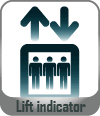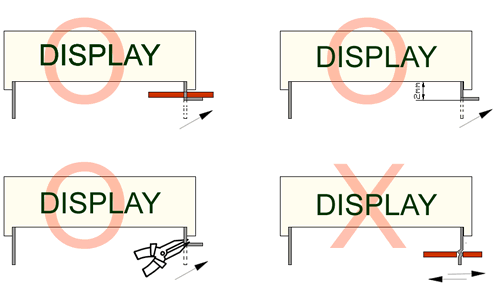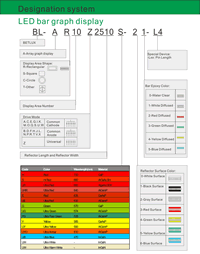LED light bar(circle ,1 bar,18.00mm)
Series No:
Weight:(g/pcs)
Dimension:(mm)
Specification:
Inquiry
Description:
Innovating Electronics with LED Bar Displays: A Deep Dive into Circle LED Light Bars
The world of electronics is continuously evolving, with LED technology at the forefront of innovation. Among these advancements, LED bar displays, particularly the LED light bar (circle, 1 bar, 18.00mm), have become essential for electronics manufacturer engineers, purchasers, and administrators. This article explores the features, applications, benefits, and real-world implications of these LED bars, offering insights through case studies and user testimonials. Our focus on professional insights underscores the transformative impact of LED bar displays in the electronics industry.
Illuminating the Path: The Role of LED Bar Displays
LED bar displays, synonymous with LED bar graphs, are a configuration of light-emitting diodes arranged to form a linear or circular pattern. These devices are celebrated for their precise light output, energy efficiency, and versatility. The circle, 1 bar, 18.00mm variant stands out for its compact design and enhanced luminosity, catering to a myriad of applications that require detailed and reliable light sources.
A Spectrum of Applications
LED bar displays find utility in a vast array of settings:
- Industrial Machinery: Improving operational visibility and safety.
- Consumer Electronics: Enhancing the user interface and aesthetics of devices.
- Automotive: Serving as indicators or backlighting for dashboards and controls.
Distinctive Features of Circle LED Light Bars
The circle, 1 bar, 18.00mm LED light bar is distinguished by several key features:
- Enhanced Brightness and Clarity: Ideal for visibility in all lighting conditions.
- Energy Efficiency: Minimizing power consumption while delivering optimal performance.
- Robustness: Designed to withstand harsh environments and prolonged use.
Beyond Illumination: Advantages of LED Bar Graphs
Adopting LED bar displays in electronic designs brings multiple benefits:
- Cost Savings: Reduced energy and maintenance expenses.
- Longevity: LED bars offer extended lifespans compared to traditional lighting solutions.
- Environmental Impact: Lower carbon emissions due to energy efficiency.
From Concept to Reality: Case Studies and Testimonials
Case studies illustrate the LED bar display’s transformative effect. For example, an electronic scoreboard manufacturer integrated these LED bars for enhanced visibility and durability, leading to improved customer satisfaction. User testimonials further affirm their advantages, with engineers praising the ease of integration and administrators noting significant reductions in operational costs.
Conclusion: Shaping the Future of Electronics with LED Bar Displays
LED bar displays, particularly the circle, 1 bar, 18.00mm variant, represent a leap forward in lighting technology within the electronics sector. Their application across diverse fields underscores their versatility and efficiency. By embracing these innovations, professionals in the electronics industry can anticipate a brighter, more efficient future.
Call to Action:
Discover how LED bar displays can transform your electronics projects. Embrace innovation and efficiency with LED technology today.

LED light bar(circle,18.00mm)
Lightbar LED
Features
- Display Area Shape: Circle, offering a distinct and aesthetically appealing area for illumination.
- Display Area Number: Features one display area.
- Outer Diameter: 18.00mm, balancing compactness with visibility.
- Inner Diameter: 15.00mm, creating a well-defined light emitting area.
- Uniform Light Emitting Area: Ensures consistent and even lighting across the display.
- Low Current Operation: Energy-efficient, reducing power consumption.
- Wide Viewing Angle: Allows the display to be easily visible from various angles.
- Easily Mounted on P.C. Boards: Designed for easy integration into electronic systems.
- Flush Mountable: Can be installed to align seamlessly with the surface for a neat appearance.
- Excellent On/Off Contrast: Enhances visibility and readability, important for circular displays.
- Can be Used with Panels and Legend Mounts: Versatile in terms of installation, suitable for various types of panels.
- Categorized for Luminous Intensity: Ensures uniform brightness across different units.
- Different Colors in One Unit Available: Offers options for various color displays, enhancing customization.
- Standard: Black Face, White Segment: Provides a classic and easily readable appearance.
- RoHS Compliance: Meets environmental and safety standards.
Applications
- Indicator Lights: Ideal for applications requiring clear circular indicator lights, such as in electronics, machinery, or other equipment.
- Control Panels: Suitable for use in control panels where a circular display is desirable.
- Signal Lights: Applicable in settings where a circular signal light is needed for indicating status or conditions.
- Instrumentation Displays: Useful for displaying status or readings in instrumentation where a round display is preferred.
- Consumer Electronics: Can be integrated into consumer electronics for display or indication purposes.
- Safety and Emergency Equipment: Suitable for use in safety devices requiring a clear, round indicator light.
- Decorative Lighting: Effective for aesthetic applications requiring a round light source.
- Wearable Technology: Ideal for incorporation into wearable devices due to its size and aesthetic appeal.
- Automotive Displays: Can be used in vehicle dashboards or control systems where round indicators are necessary.


Electrical-optical characteristics:
Article No | Emitting Color | Material | Peak Wavelength (nm) | Voltage typ. (v) | Voltage max. (v) | Luminous min | Luminous typ |
|---|---|---|---|---|---|---|---|
BL-AC1Z18D2 |
Super Red |
GaAlAs/DH |
660 |
2.2 |
5 |
10 |
|
BL-AC1Z18E2 |
Orange |
GaAsP/GaP |
635 |
2.5 |
2.2 |
5 |
|
BL-AC1Z18G2 |
Green |
GaP/GaP |
570 |
2.5 |
2.2 |
5 |
|
BL-AC1Z18H2 |
Red |
GaP/GaP |
700 |
2.6 |
0.2 |
0.5 |
|
BL-AC1Z18PG2 |
Ultra Pure Green |
InGaN/SiC |
525 |
4.2 |
7 |
12 |
|
BL-AC1Z18S2 |
Hi Red |
GaAlAs/SH |
660 |
2.2 |
2 |
5 |
|
BL-AC1Z18UB2 |
ultra Blue |
InGaN/SiC |
470 |
4.2 |
12 |
20 |
|
BL-AC1Z18UE2 |
Ultra Orange |
AlGaInP |
630 |
2.5 |
5 |
8 |
|
BL-AC1Z18UG2 |
Ultra Green |
AlGaInP |
574 |
2.5 |
5 |
8 |
|
BL-AC1Z18UR2 |
Ultra Red |
GaAlAs/DDH |
660 |
2.2 |
8 |
20 |
|
BL-AC1Z18UW2 |
Ultra White |
InGaN |
- |
4.2 |
30 |
||
BL-AC1Z18UY2 |
Ultra Yellow |
AlGaInP |
590 |
2.5 |
5 |
8 |
|
BL-AC1Z18Y2 |
Yellow |
GaAsP/GaP |
585 |
2.5 |
2.2 |
5 |
Package configuration & Internal circuit diagram
Partno description:
Related Information
Applied for:




1. Application
The Seven Segment LED is widely applied for ordinary electronic equipment (such as office equipment,
communication equipment and household applications). Checking with BETLUX’s Sales in
advance for information on applications in which exceptional reliability is required, particularly
when the failure or malfunction of the LEDs may directly jeopardize life or health (such as in
aviation, transportation, traffic control equipment, medical and life support systems and safety
devices).
2. Storage
The storage ambient for the Seven Segment LED should not exceed 30℃ temperature or 70% relative humidity.
For extended storage out of their original packaging, it is recommended that the Seven Segment LEDs be stored
in a sealed container with appropriate desiccant, or in a desiccator with nitrogen ambient.
3. Cleaning
Avoid using any unspecified chemical solvent to clean LED . For example, Trichloroethylene, Chlorosen, Acetone, and Diflon S3MC.
Any cleaning method can only be taken under normal temperature in one minute or less if it is required.
Use water to clean the Seven Segment LED if necessary under room temperature
dry it immediately after that.
4.Forming
Any unsuitable stress applied to the epoxy may break bonding wires in LED
Any forming on lead pin must be done before soldering, not during or after soldering.
Avoid applying any stress to resin in order to prevent the epoxy fracture and break on bonding wire.
While forming, please use a tie bar cut or equivalent to hold or bend the pin.
2mm from the base of resin is the minimum distance for the place bending the lead pin.
Avoid bending the lead pin at the same point twice or more.

Soldering
When soldering, leave a minimum of 2mm clearance from the base of the base of the lens to the soldering point. Dipping the lens into the solder must be avoided.
Do not apply any external stress to the lead frame during soldering while the LED is at high temperature.
Recommended soldering conditions:
| IR Reflow Soldering (for SMD display) | Wave Soldering | Soldering Iron | |||
| Pre-Heat | 150-180°C | Pre-Heat | 100°C Max. | Temperature | 300°C Max. |
| Pre-Heat Time | 120sec Max. | Pre-Heat Time | 60sec Max. | ||
| Peak Temperature | 260°C Max. | SolderWave | 260°C Max. | Soldering Time | 3sec Max.(one time only) |
| Soldering Time | 10 sec Max. | Soldering Time | 5sec Max. | ||
Note: Excessive soldering temperature and/or time might result in deformation of the LED lens or failure of the LED
ESD(Electrostatic Discharge)
Static Electricity or power surge will damage the LED.
Suggestions to prevent ESD (Electrostatic Discharge):
n Use a conductive wrist band or anti-electrostatic glove when handling these LEDs
n All devices, equipment, and machinery must be properly grounded
n Work tables, storage racks, etc. should be properly grounded
n Use ion blower to neutralize the static charge which might have built up on surface of the LED’s
plastic lens as a result of friction between LEDs during storage and handling
ESD-damaged LEDs will exhibit abnormal characteristics such as high reverse leakage current,
low forward voltage, or “no light on” at low currents. To verify for ESD damage, check for “light on”
and Vf of the suspect LEDs at low currents.
The Vf of “good” LEDs should be>2.0V@0.1mA for InGaN product and >1.4V@0.1mA for AlInGaP
product.

LED dirve IC by Maxim Integrated
MAX6959 4½-Digit LED Display Driver
MAX6958 4½-Digit LED Display Driver
MAX6955 7-, 14-, 16-Segment LED Display Driver
MAX6956 LED Static Display Driver and I/O Port
MAX6954 7-, 14-, 16-Segment LED Display Driver
MAX6952 5 x 7 Matrix LED Display Driver
MAX6957 LED Static Display Driver and I/O Port
MAX6950 5-Digit LED Display Driver
MAX6951 8-Digit LED Display Driver
ICM7212 4-Digit LED Driver
ICM7212A 4-Digit LED Driver
ICM7212AM 4-Digit LED Driver
ICM7212M 4-Digit LED Driver
ICM7218A 8-Digit LED Driver
ICM7218B 8-Digit LED Driver
ICM7218C 8-Digit LED Driver
ICM7218D 8-Digit LED Driver
MAX7221 8-Digit LED Display Driver
MAX7219 8-Digit LED Display Driver
When selecting power for LED systems, it’s essential to understand several key parameters to ensure safe operation, longevity, and optimal performance. Here are some steps and considerations for LED power selection:
- Determine the Forward Voltage (Vf) of the LED(s):
Each LED has a forward voltage, which is the voltage at which the LED operates when the current is flowing through it. This value can typically be found in the LED’s datasheet.
- Determine the Forward Current (If) of the LED(s):
The forward current is the current at which the LED is designed to operate. Running an LED at higher than its rated current can reduce its lifespan and increase the heat it produces.
- Decide on the Configuration:
Series Configuration: When LEDs are connected in series, the forward voltages add up, but the current remains the same.
Parallel Configuration: When LEDs are connected in parallel, the forward voltage remains the same, but the currents add up. This configuration can be risky because if one LED fails or has a slightly lower forward voltage, it can cause the other LEDs to draw more current.
Calculate Total Power Requirements:
Power (W) = Total Forward Voltage (V) x Total Forward Current (A)
For example, if you have three LEDs connected in series, each with a forward voltage of 3V and a forward current of 20mA, the total power requirement would be:
Power = (3V + 3V + 3V) x 20mA = 9V x 0.02A = 0.18W
- Select an Appropriate Power Supply:
- Voltage Rating: The power supply voltage should match or slightly exceed the total forward voltage of your LED configuration.
- Current Rating: The power supply’s current rating should meet or exceed the total forward current of your LED configuration.
- Safety Margin: It’s a good practice to select a power supply that can provide at least 20% more power than your calculated requirement. This ensures the power supply isn’t operating at its maximum capacity, which can extend its life and ensure safer operation.
- Consider Additional Features:
- Dimming Capability: If you want to control the brightness of your LEDs, choose a power supply with dimming capabilities.
- Overcurrent and Overvoltage Protection: To protect your LEDs, select a power supply with built-in protection mechanisms.
- Thermal Management: Ensure that the power supply has adequate cooling, especially if it will be enclosed or in a location with limited airflow.
- Regulation and Efficiency:A power supply with good regulation will maintain a consistent voltage output despite variations in the load. High efficiency ensures minimal power is wasted as heat.
- Physical Size and Form Factor:Depending on where you plan to place the power supply, its size and shape may be critical factors.
In summary, when selecting power for LED systems, understanding your LED’s requirements and the configuration you plan to use is essential. Then, pick a power supply that meets those needs with some added safety margin, keeping in mind any additional features or constraints relevant to your project.
Here are some well-regarded brands in the industry:
- Mean Well: One of the most recognized brands in the LED power supply industry, Mean Well offers a wide range of products suitable for both indoor and outdoor applications. Their units often come with features like overcurrent protection, dimming capabilities, and high efficiency.
- Tridonic: A global leader in lighting technology, Tridonic offers LED drivers and power supplies that cater to various lighting solutions, from simple setups to advanced smart lighting systems.
- Philips Advance Xitanium: Philips is a well-known brand in the lighting industry, and their Xitanium series of LED drivers are known for reliability and performance. They cater to both indoor and outdoor LED applications.
- Osram: Another giant in the lighting industry, Osram offers a range of LED drivers and power supplies suitable for various applications, including architectural and street lighting.
- LIFUD: Specializing in LED drivers, LIFUD is known for its high-quality products that cater to both commercial and residential LED lighting solutions.
- MOSO: This brand offers a variety of LED drivers, especially for outdoor and industrial applications. Their products are known for durability and performance.
- TDK-Lambda: With a history in power electronics, TDK-Lambda offers a range of power supplies and LED drivers suitable for various applications, emphasizing reliability and advanced features.







